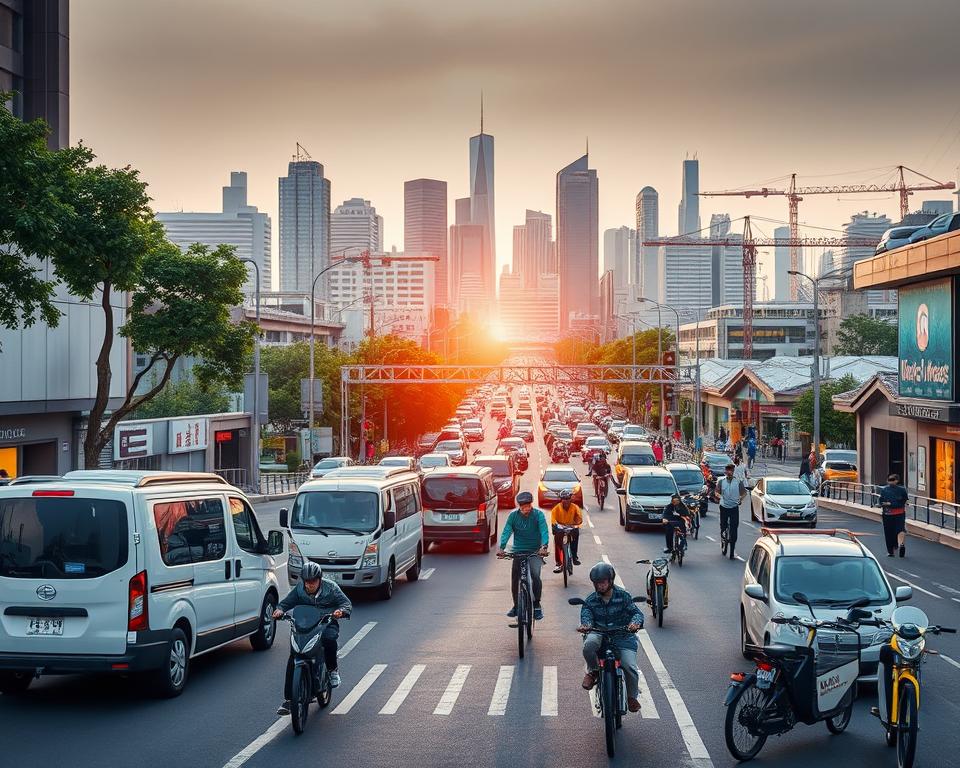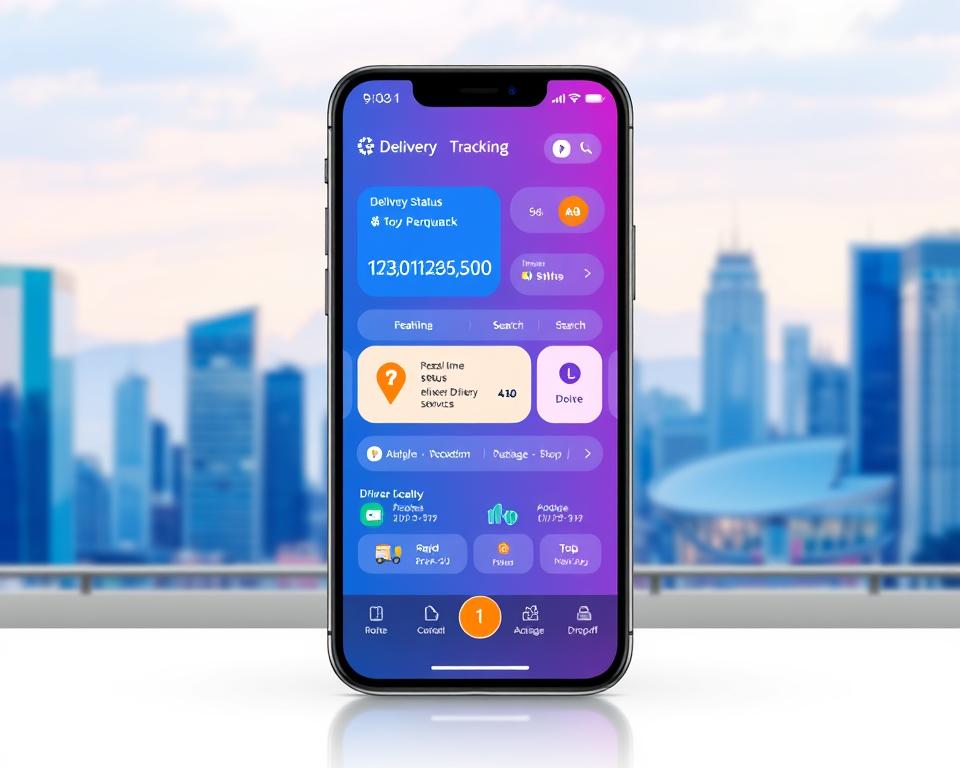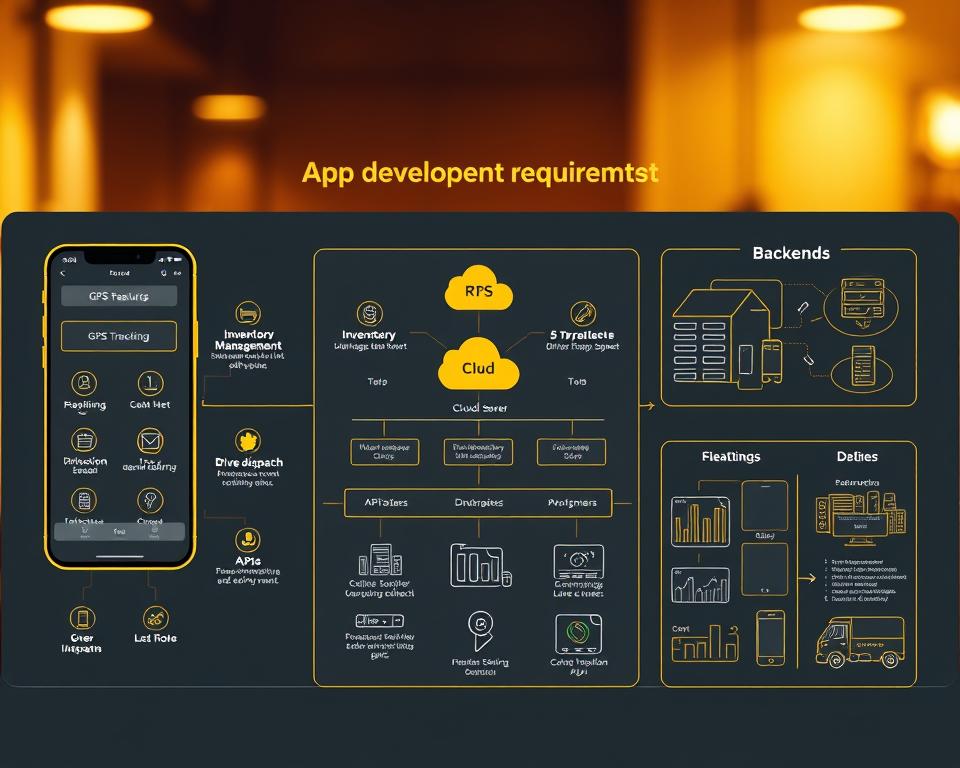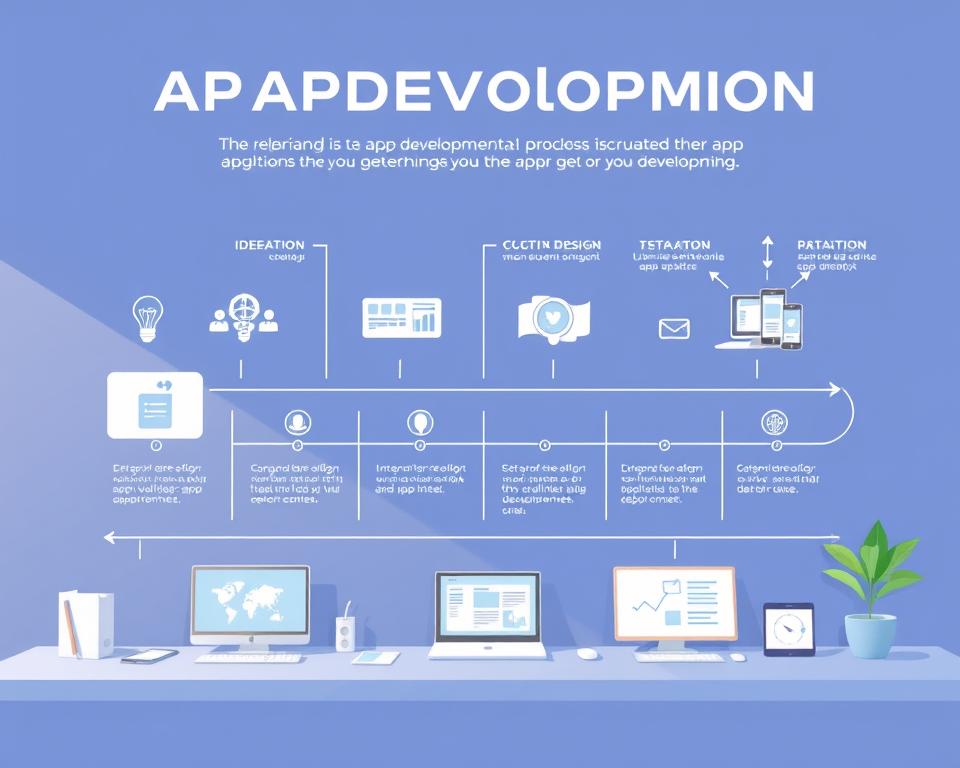To make a last-mile delivery app like Uber Freight, you need to know the logistics and on-demand delivery world well. Last-mile delivery is key in logistics, taking packages from a hub to your door. A good app is vital for smooth, timely, and safe deliveries.
The last-mile delivery market is booming, thanks to the need for quick and dependable delivery. Companies like Uber Freight are at the forefront, offering new solutions for logistics and on-demand delivery. To create a top-notch app, understanding the market is crucial. This includes knowing the market size, growth, key players, and challenges.
In this article, we’ll dive into making a last-mile delivery app like Uber Freight. We’ll cover the must-have features, technical needs, and success strategies. We’ll also talk about the role of route optimization, AI, and security in making the app efficient and reliable.
Table of Contents
Introduction to Last-Mile Delivery
Last-mile delivery is vital in the logistics world. It’s more important than ever with the rise of e-commerce. The need for fast and reliable delivery has skyrocketed, making last-mile delivery a major focus for logistics companies.
Key Takeaways
- Creating a last-mile delivery app needs a deep grasp of logistics and on-demand delivery.
- The last-mile delivery market is expanding fast, driven by the need for quick and reliable delivery.
- A well-designed app is key for managing last-mile delivery, ensuring timely and safe deliveries.
- Route optimization, AI, and security are essential for a successful last-mile delivery app.
- Knowing the market, including key players and challenges, is vital for app success.
- Last-mile delivery is crucial in logistics, and its importance cannot be overstated.
- The growth of e-commerce has boosted the demand for fast and reliable delivery, making last-mile delivery a major focus for logistics companies.
Understanding the Last-Mile Delivery Market Landscape
The last-mile delivery market is changing fast. This is because of new consumer needs and tech advancements. The logistics industry is growing a lot, with last-mile delivery being key. Companies are spending a lot on solutions to meet the demand for quick and reliable delivery.
The market size is big and it’s expected to grow even more. Key players are working on new ways to be more efficient and cut costs. The market is seeing more demand for same-day delivery, more online shopping, and a need for green delivery options.
Current Market Size and Growth Projections
The last-mile delivery market is already big and it’s going to get even bigger. It’s expected to grow by 15-20% each year. This growth is because people want their deliveries fast and reliable.
Key Players Analysis
Big names like UPS, FedEx, and DHL are leading the market. They’re investing in tech and infrastructure to better their delivery services. This helps them stay competitive.
Market Opportunities and Challenges
The market has both chances and hurdles. Opportunities include more demand for same-day delivery, more online shopping, and green delivery options. But, there are challenges like high costs, traffic, and lack of infrastructure.
The last-mile delivery market is complex and always changing. It’s important for companies to understand these changes. By looking at last-mile delivery trends and the market landscape, companies can improve their services. This helps them meet their customers’ needs better.
Essential Features of a Last-Mile Delivery App Like Uber Freight
Creating a last-mile delivery app needs features for both customers and drivers. App features like real-time tracking, efficient routes, and easy payments are key. These features help make the app user-friendly.
Delivery management is crucial in last-mile delivery. It means making routes better to save time and please customers. Using route optimization algorithms helps make deliveries faster and cheaper.
Some important features of a last-mile delivery app are:
- Real-time tracking and updates
- Efficient routing and navigation
- Seamless payment integration
- Driver management and scheduling
- Customer support and feedback mechanisms
By adding these features, developers can make a top-notch last-mile delivery app. It will be great for both customers and drivers.
| Feature | Description |
|---|---|
| Real-time tracking | Allows customers to track their packages in real-time |
| Route optimization | Optimizes routes to reduce delivery times and increase efficiency |
| Seamless payment integration | Allows customers to pay for deliveries securely and efficiently |
Technical Requirements for App Development
Creating a last-mile delivery app needs a deep understanding of technical needs. This includes planning the app’s development, backend, frontend, and database. A good plan ensures the app works well with many users and transactions.
The app’s tech needs cover backend infrastructure like servers and data storage. The frontend development focuses on how users interact with the app. Also, database architecture planning is key for efficient data handling.
Key Technical Requirements
- Backend infrastructure requirements, such as server capacity and data storage
- Frontend development considerations, such as user interface and user experience
- Database architecture planning, including data modeling and schema design
Knowing these tech needs helps developers make a user-friendly last-mile delivery app. A well-planned app development process is essential. It ensures the backend, frontend, and database work together smoothly.
Best Practices for App Development
Good app development practices include using agile methods and thorough testing. It’s also important to make sure the app is secure and follows regulations. These practices help create a reliable and efficient app that meets user needs.
| Technical Requirement | Description |
|---|---|
| Backend Infrastructure | Server capacity, data storage, and network security |
| Frontend Development | User interface and user experience |
| Database Architecture | Data modeling and schema design |
Building the Driver-Side Interface
Creating a user-friendly driver interface is key for a last-mile delivery app’s success. A good interface boosts driver happiness and work efficiency, leading to better service for customers. The user experience of the driver interface should be straightforward. It should let drivers easily navigate, accept deliveries, and update their status in real-time.
To get this right, the mobile app design must focus on simplicity and clarity. The interface should be simple to use, with clear instructions and little clutter. A well-designed driver interface also helps keep drivers happy, as they prefer using apps that are easy to navigate.
Some important features of a good driver interface include:
- Real-time updates and notifications
- Easy-to-use navigation and routing
- Clear and concise instructions
- Minimal clutter and intuitive design
By focusing on the driver interface and user experience, last-mile delivery apps can make drivers happier and more efficient. This leads to better service for customers and higher satisfaction. The mobile app design must be thoughtfully planned to meet the needs of both drivers and customers.
Creating the Customer-Side Experience
To make a successful last-mile delivery app, focus on the customer experience. This experience affects how happy and loyal customers are. A good experience comes from features like user registration, shipment tracking, and payment options. These features make the app better, leading to more loyal customers.
A good user registration process is key. It should be easy, safe, and quick. This lets customers sign up and start using the app without trouble. Also, shipment tracking keeps customers updated on their deliveries. This gives them control and clarity.
- Simple and secure user registration and authentication
- Real-time shipment tracking updates
- Convenient payment integration options
By adding these features and focusing on the customer experience, businesses can build a loyal customer base. This helps them stay competitive in the last-mile delivery market.
Implementing Real-Time Tracking Systems
Real-time tracking is key in last-mile delivery apps. It lets customers see where their deliveries are. This is thanks to GPS technology, which gives exact locations and delivery updates. Real-time tracking makes deliveries better and customers happier.
Some big pluses of real-time tracking are:
- Increased customer satisfaction
- Improved delivery accuracy
- Enhanced supply chain visibility
To start real-time tracking, use GPS technology to follow delivery vehicles. Then, send delivery updates to customers. This can be through a mobile app or website, so customers can track their orders in real-time.
By offering real-time tracking and delivery updates, businesses gain customer trust. This makes the delivery experience better. It can also make customers more loyal, helping the business grow.
| Feature | Benefit |
|---|---|
| Real-time tracking | Increased customer satisfaction |
| GPS technology | Improved delivery accuracy |
| Delivery updates | Enhanced supply chain visibility |
How to Develop a Last-Mile Delivery App Like Uber Freight: Step-by-Step Process
The app development process for a last-mile delivery app like Uber Freight starts with planning. You need to define the project scope, know your target audience, and decide on the app’s features.
A good planning phase is key to success. It involves making a detailed project plan. This includes the development timeline, budget, and who will work on it. The development timeline should be realistic, based on the project’s complexity and the team’s experience.
Some important things to think about during app development are:
- Defining the project scope and requirements
- Creating a detailed project plan and development timeline
- Identifying and allocating the necessary resources
- Developing a robust and scalable architecture
- Conducting thorough testing and quality assurance
By following these steps and considering these factors, you can make a successful app. Your last-mile delivery app will meet the needs of your audience.
| Stage | Description |
|---|---|
| Planning Phase | Define project scope, identify target audience, and determine required features and functionalities |
| Development Timeline | Create a detailed project plan, including budget and resource allocation |
| Testing and Quality Assurance | Conduct thorough testing to ensure the app meets the required standards |
Integration of Payment Gateways and Security Measures
When making a last-mile delivery app, it’s key to add secure payment gateways. You also need strong security to keep user data safe. This means looking at different ways to pay, like credit cards and mobile wallets, for a smooth and safe user experience.
The payment gateways must follow industry standards, like PCI-DSS, to keep user info safe. The app should also use encryption and firewalls to stop unauthorized access and protect data.
The app must follow laws like GDPR and CCPA to protect user data and keep trust. By focusing on secure payment gateways and strong security, developers can make a reliable last-mile delivery app.
Some important things to think about for payment gateways and security are:
- Following industry standards and laws
- Using strong security like encryption and firewalls
- Doing regular security checks to find weak spots
- Telling users clearly about how payments and security work
By looking at these points and focusing on secure payment gateways and strong security, developers can make a trustworthy last-mile delivery app. This app will meet user needs and stay competitive in the market.
Route Optimization and AI Implementation
Route optimization is key in last-mile delivery. It cuts down delivery times and costs. Using route optimization software helps companies run their logistics better. AI implementation is crucial here. It allows for real-time tracking and analysis of routes, considering traffic and road conditions.
Route optimization brings many benefits:
- Less fuel used and lower emissions
- Quicker and more accurate deliveries
- Happier customers and more loyalty
- Better logistics optimization and lower costs
With AI implementation and route optimization, companies can stand out in the last-mile delivery market. They can also enhance their logistics optimization strategies.
Building the Admin Dashboard
The admin dashboard is key for a last-mile delivery app. It’s where you manage operations, track performance, and make smart decisions. A good dashboard should have analytics features that show important stats like delivery times and customer happiness.
Managing your fleet well is also crucial. It lets you plan routes, use resources wisely, and keep an eye on vehicle health in real-time. With fleet management tools in the dashboard, you can run your operations smoother, cut costs, and boost efficiency.
Key Features of the Admin Dashboard
- Real-time tracking and monitoring of deliveries
- Analytics and reporting tools for performance optimization
- Fleet management tools for route optimization and resource allocation
- Integration with payment gateways and security measures
By adding these features to the admin dashboard, last-mile delivery apps give admins a full platform. They can manage their operations, make informed decisions, and grow their business.
| Feature | Description |
|---|---|
| Analytics Features | Provide insights into key performance indicators, such as delivery times and customer satisfaction |
| Fleet Management Tools | Enable administrators to optimize routes, allocate resources, and monitor vehicle performance in real-time |
| Reporting Systems | Offer detailed reports on performance, revenue, and customer behavior |
Monetization Strategies for Your Delivery App
Creating a good monetization strategy is key for a delivery app’s success. To make money and stay afloat, different revenue models can be used. These include taking a cut of sales, offering subscriptions, and showing ads.
Choosing the right revenue models for your app is important. For example, taking a cut of sales works well for apps that connect buyers and sellers. But, if your app offers extra features or fast delivery, subscriptions might be better.
- Commission-based models: charging a percentage of the transaction amount
- Subscription services: offering premium features or priority delivery for a monthly fee
- Advertising: displaying ads within the app and charging advertisers for impressions or clicks
By using smart monetization strategies and revenue models, your delivery app can thrive. As more people want delivery apps, having a solid plan is crucial to stay ahead.
Quality Assurance and Testing Protocols
Ensuring the quality and reliability of a last-mile delivery app is key to its success. Quality assurance means checking the app for issues before it’s released. This includes performance testing to see how fast and scalable the app is.
Security testing is also important to keep user data safe. By doing these tests, developers can make users happier and lower risks. Some main parts of testing are:
- Performance testing to check the app’s speed and how it handles more users
- Security testing to keep user data safe and avoid legal problems
- User experience testing to make sure the app is easy to use
By using these tests in the app’s making, developers can make sure it’s top-notch.
| Testing Protocol | Purpose |
|---|---|
| Performance Testing | To check the app’s speed, scalability, and overall performance |
| Security Testing | To keep user data safe and avoid legal issues |
| User Experience Testing | To make sure the app is easy and smooth to use |
Marketing and Launch Strategy
A good marketing strategy is key to drawing in users and making a mark in the last-mile delivery market. It’s about having a solid launch plan. This plan should include social media, influencer partnerships, and special offers to get people excited about the app’s debut.
For a successful app promotion strategy, consider these points:
- Know who your audience is and what they want.
- Highlight what makes your app special.
- Make your content and ads interesting and engaging.
- Use social media and team up with influencers.
By using these tactics in your marketing strategy, your app can attract and keep users. This will help your business grow and succeed.
| Marketing Strategy | Launch Plan | App Promotion |
|---|---|---|
| Social media campaigns | Influencer partnerships | Promotional offers |
| Content creation | Target audience identification | Engagement metrics tracking |
Scaling and Maintenance Considerations
As a last-mile delivery app grows, having a scaling plan is key. This ensures smooth operations. You need to scale your infrastructure to handle more users without losing performance.
Here are some strategies to consider:
- Keep an eye on app performance and find ways to improve
- Set up maintenance times to reduce downtime and update apps quickly
- Invest in infrastructure scaling to meet growing needs
Focus on scaling and maintenance to keep your app efficient and secure. This boosts user happiness and loyalty, helping your business grow.
Don’t forget the role of performance optimization in scaling. This means making your app faster, reducing delays, and making it more responsive.
By being proactive in scaling and maintenance, your app can thrive. Stay competitive in the fast-changing logistics world.
Conclusion
Creating a last-mile delivery app like Uber Freight needs careful thought. You must consider market trends, technical needs, and user experience. As demand for fast and reliable delivery grows, it’s key to make an app that fits the logistics and delivery world’s changing needs.
A good last-mile delivery app focuses on easy-to-use interfaces, real-time tracking, and smooth payments. These features help improve customer happiness, cut costs, and boost efficiency. The app-making process should include detailed testing and quality checks for a smooth user experience.
In last-mile delivery, app development is key to making logistics better and speeding up deliveries. Using the newest tech and trends, companies can come up with creative solutions for the industry’s unique problems. Keeping up with the latest in last-mile delivery and app development is crucial.
Understanding last-mile delivery’s complexities and app development’s role helps businesses make effective solutions. These solutions can drive growth, make customers happier, and keep companies competitive. With the right strategy, companies can overcome logistics and delivery challenges and find lasting success.


















